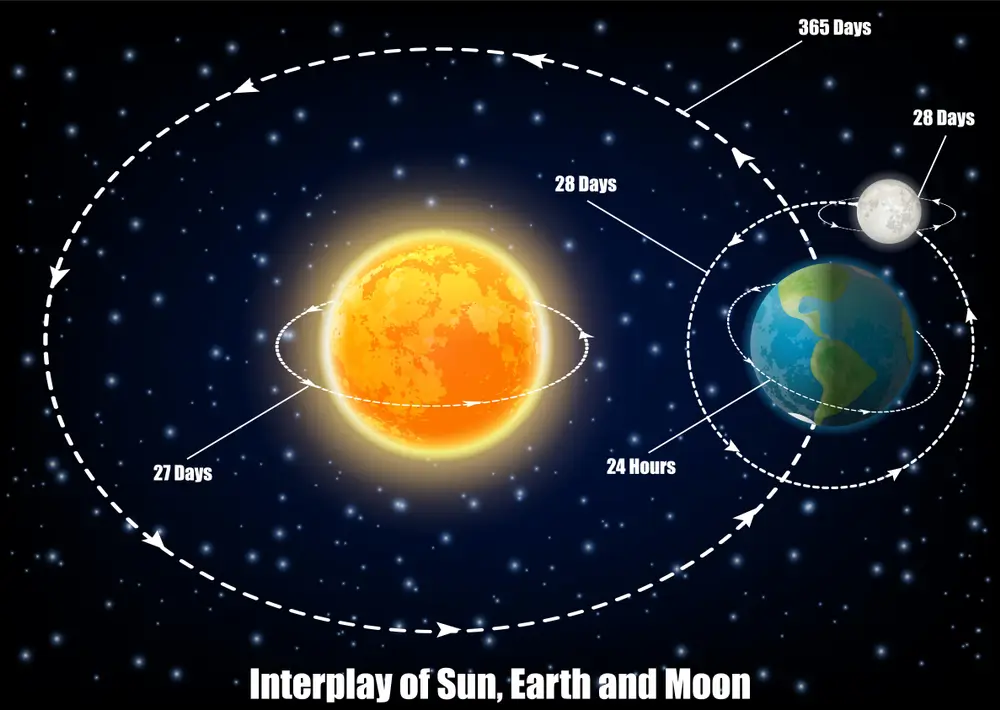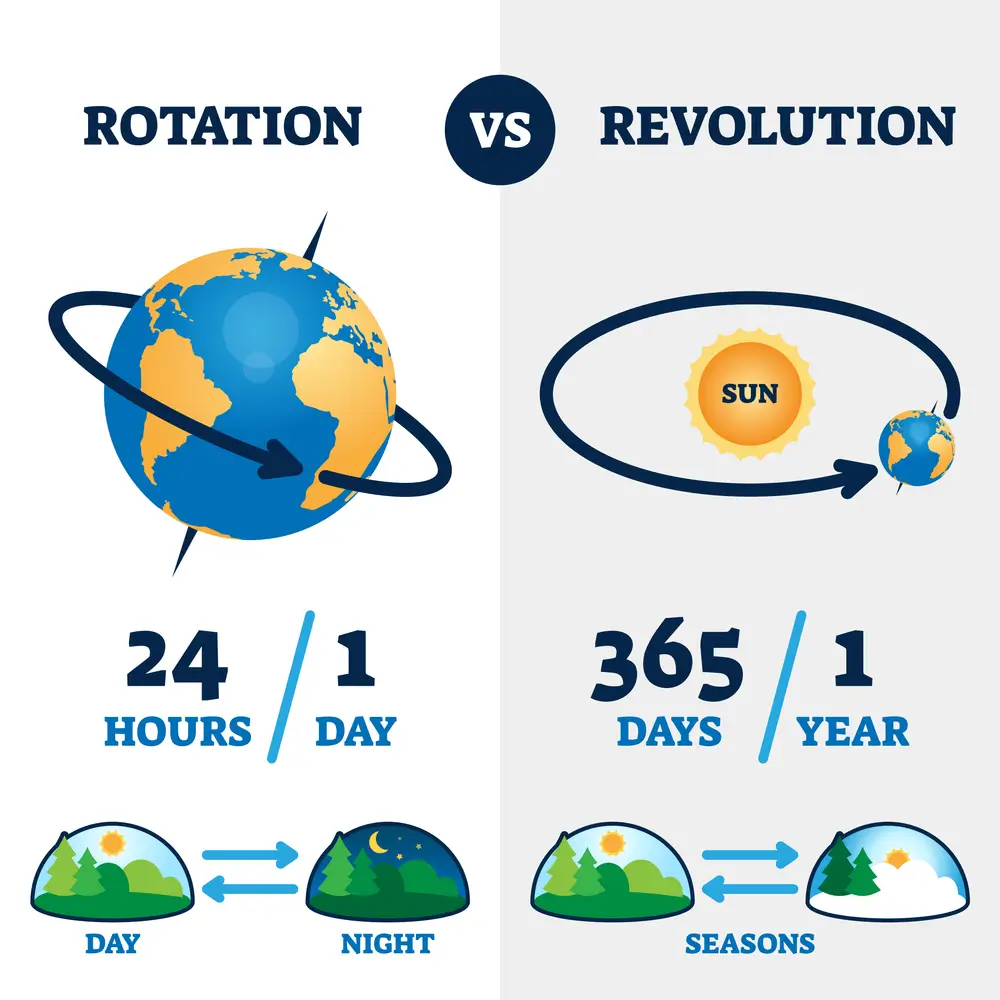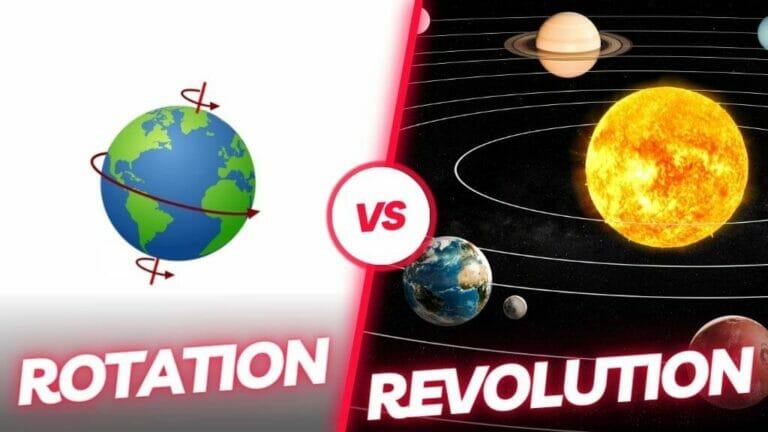Circular motion, like the motion of planets in their orbits, is used to describe movement over curved paths. Revolution and rotation are the two essential concepts explored in circular motion.
The difference between rotation and revolution is that revolution occurs when an object moves in a circular path around another object. On the other hand, rotation is the movement in a circle around an axis. The rotation and revolution of the Earth both occur at a constant pace and in an anticlockwise direction.
For a better understanding of the differences, let’s first learn the definitions:
Table of Contents
What is Rotation?

Rotation refers to the motion of the Earth’s axis. The axis of the Earth, which runs from the north to the south poles, is an imaginary line that passes through the planet and causes it to rotate once every day.
Because of how the Earth rotates, there are obvious patterns like day and night. At any given time, the Sun shines on half of the planet; that side is warmer and brighter; that side is daylight; the other side faces away from the Sun; that side is dark; that side is nighttime.
The Earth rotates anticlockwise from west to east, and since different parts of the Earth pass through the Sun’s light as it rotates, the Sun appears to rise in the east and set in the west.
It takes the Earth 23 hours and 56 minutes to complete one full rotation; we round this to 24 hours, which we refer to as a day.
Importance of Rotation
The following is a list of some of the significance of the Earth’s rotation:
- The daily cycle of light and dark, temperature swings, and changes in humidity are caused by the rotation of the Earth.
- Ocean and sea tides are a result of the Earth’s rotation.
If the Earth’s rotation creates a day, what creates a year? The answer to this question is a revolution; let’s study more about a revolution in the following definition.
Learn more: What is the Difference Between Melodramatic and Dramatic?
What is Revolution?

A revolution is a fixed-path rotation of the Earth around the Sun. The Earth rotates anticlockwise, that is, from west to east. Around one year or exactly 365.242 days, pass during one Earth revolution around the Sun.
In addition to rotating on its axis, the Earth also rotates in orbits around the Sun. One full orbit around the Sun equals one revolution, and it takes the Earth 365 days to complete one. Our calendar indicates that there are 365 days in a year.
The period, denoted by the symbol T, is the length of time it takes an object to make one revolution around a circle.
Importance of Revolution
The following is a list of some of the significance of the Earth’s revolution:
- Seasons are a result of a revolution.
- The revolution directly influences the various day and nighttime lengths. At the equator, the length of the day and night is equal. The eclipse occurs at this time.
- The length of the day and night varies in the Northern and Southern hemispheres.
Difference Between Rotation and Revolution

There are many differences between rotation and revolution are given below:
Rotation and revolution are two words that mean very different things. When we discuss rotation, we mean the movement of an object about the axis that is located in the body’s center.
When we talk about a revolution, we’re talking about how one object rotates around another item or another axis.
The main difference between rotation and revolution is that an object’s location does not change while it rotates. Revolution causes a change in position.
Another difference between rotation and revolution is that a revolution is motion about a different axis, whereas a rotation revolves about one’s own axis.
Rotation therefore refers to the motion of the planet around its own axis. Revolution occurs when the planet revolves around the axis of the Sun.
In comparison between rotate vs. revolve, the Earth’s revolution lasts around 365 days, while its rotation lasts about 24 hours.
Clock hands and spinning tops are a couple very common examples of rotation. The typical examples of revolution, though, include rounding a corner in an automobile, a child’s merry-go-round, etc.
Rotate Vs. Revolve
The comparison between rotate vs. revolve is given below:
Rotate Definition
Rotate means to circle around a center point. We can rotate something by moving it about an axis, but it will still be the same; we are only changing its coordinates.
Revolve Definition
Revolve is the movement of one thing around another. Revolution” describes how an object is orbiting another thing. For instance, the 24-hour day is created as the Earth rotates on its own axis. The 365-day year is made possible by the Sun’s rotation of the Earth.
What are the Differences Between Rotation and Revolution?
Highlighting the main differences between rotation and revolution in the following table:
| Rotation | Revolution |
|---|---|
| The rotation of the Earth revolves around its axis. | Revolution describes a rotary motion around an axis that is external to the item. |
| Day and night are caused by the earth’s rotation, which moves from west to east. | Seasons are formed by the anticlockwise revolution of the planet. |
| The Earth rotates on its axis. | The Earth revolves around the sun. |
| Example: Clock hands, a spinning top, etc. | Example: Getting on a merry-go-round or driving around a curve. |
Conclusion
Therefore, you may have learned enough about the two terms from the above discussion to make sure everything is clear in the future. The difference between rotation and revolution is that revolution is the opposite of rotation since it involves traveling around another object. Using the Earth as an example, a revolution around the Sun takes the planet 366 times to complete.
For example, the Earth rotates on its own axis and revolves around the Sun, whereas rotating is on its own axis and revolution is around something.
See more: What is the Difference Between Like and Unlike Fractions?


